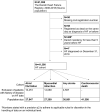Social determinants of health and cardiovascular outcomes in patients with heart failure
- PMID: 35924957
- PMCID: PMC9786545
- DOI: 10.1111/eci.13843
Social determinants of health and cardiovascular outcomes in patients with heart failure
Abstract
Background: We examined the associations between family income and educational attainment with incident atrial fibrillation (AF), myocardial infarction (MI), stroke and cardiovascular (CV) death among patients with newly-diagnosed heart failure (HF).
Methods: In a nationwide Danish registry of HF patients diagnosed between 2008 and 2018, we established a cohort for each outcome. When examining AF, MI and stroke, respectively, patients with a history of these outcomes at diagnosis of HF were excluded. We used cause-specific proportional hazard models to estimate hazard ratios for tertile groups of family income and three levels of educational attainment.
Results: Among 27,947 AF-free patients, we found no association between income or education and incident AF. Among 27,309 MI-free patients, we found that lower income (hazard ratio 1.28 [95% CI 1.11-1.48] and 1.11 [0.96-1.28] for lower and medium vs. higher income) and education (1.23 [1.04-1.45] and 1.15 [0.97-1.36] for lower and medium vs. higher education) were associated with MI. Among 36,801 stroke-free patients, lower income was associated with stroke (1.38 [1.23-1.56] and 1.27 [1.12-1.44] for lower and medium vs. higher income) but not education. Lower income (1.56 [1.46-1.67] and 1.32 [1.23-1.42] for lower and medium vs. higher income) and education (1.20 [1.11-1.29] and 1.07 [0.99-1.15] for lower and medium vs. higher education) were associated with CV death.
Conclusions: In patients with newly-diagnosed HF, lower family income was associated with higher rates of acute MI, stroke and cardiovascular death. Lower educational attainment was associated with higher rates of acute MI and cardiovascular death. There was no evidence of associations between income and education with incident AF.
Keywords: atrial fibrillation; cardiovascular death; education; income; myocardial infarction; stroke.
© 2022 The Authors. European Journal of Clinical Investigation published by John Wiley & Sons Ltd on behalf of Stichting European Society for Clinical Investigation Journal Foundation.
Conflict of interest statement
LF: Supported by a grant from the Health Research Foundation of Central Denmark Region. Consultant for Pfizer and BMS. GYHL: Consultant and speaker for BMS/Pfizer, Boehringer Ingelheim and Daiichi‐Sankyo. Remaining authors declare no conflicts of interest. No fees are received personally.
Figures
Similar articles
-
Vascular Disease and Risk Stratification for Ischemic Stroke and All-Cause Death in Heart Failure Patients without Diagnosed Atrial Fibrillation: A Nationwide Cohort Study.PLoS One. 2016 Mar 25;11(3):e0152269. doi: 10.1371/journal.pone.0152269. eCollection 2016. PLoS One. 2016. PMID: 27015524 Free PMC article.
-
Social determinants of health and catheter ablation after an incident diagnosis of atrial fibrillation: a Danish nationwide cohort study.Eur Heart J Qual Care Clin Outcomes. 2023 Jun 21;9(4):389-396. doi: 10.1093/ehjqcco/qcac038. Eur Heart J Qual Care Clin Outcomes. 2023. PMID: 35810004
-
Cardiovascular Events after New-Onset Atrial Fibrillation in Adults with CKD: Results from the Chronic Renal Insufficiency Cohort (CRIC) Study.J Am Soc Nephrol. 2018 Dec;29(12):2859-2869. doi: 10.1681/ASN.2018050514. Epub 2018 Oct 30. J Am Soc Nephrol. 2018. PMID: 30377231 Free PMC article.
-
Bariatric surgery and cardiovascular disease: a systematic review and meta-analysis.Eur Heart J. 2022 May 21;43(20):1955-1969. doi: 10.1093/eurheartj/ehac071. Eur Heart J. 2022. PMID: 35243488 Free PMC article.
-
The imminent epidemic of atrial fibrillation and its concomitant diseases - Myocardial infarction and heart failure - A cause for concern.Int J Cardiol. 2019 Jul 15;287:162-173. doi: 10.1016/j.ijcard.2018.11.123. Epub 2018 Nov 30. Int J Cardiol. 2019. PMID: 30528622 Free PMC article. Review.
Cited by
-
Social determinants of health and clinical outcomes among patients with atrial fibrillation: evidence from a global federated health research network.QJM. 2024 Jun 4;117(5):353-359. doi: 10.1093/qjmed/hcad275. QJM. 2024. PMID: 38060301 Free PMC article.
-
Impact of Social Determinants of Health on Cardiovascular Disease.J Am Heart Assoc. 2025 Mar 4;14(5):e039031. doi: 10.1161/JAHA.124.039031. Epub 2025 Mar 4. J Am Heart Assoc. 2025. PMID: 40035388 Free PMC article. Review.
-
The Danish Heart Failure Registry: A Validation Study of Content.Clin Epidemiol. 2022 Dec 28;14:1585-1594. doi: 10.2147/CLEP.S390898. eCollection 2022. Clin Epidemiol. 2022. PMID: 36597506 Free PMC article.
-
Identifying Demographic and Clinical Determinants of Ischemic Workup in Patients with Heart Failure.J Clin Med. 2024 Nov 29;13(23):7279. doi: 10.3390/jcm13237279. J Clin Med. 2024. PMID: 39685737 Free PMC article.
-
Heart Failure Epidemiology and Outcomes Statistics: A Report of the Heart Failure Society of America.J Card Fail. 2023 Oct;29(10):1412-1451. doi: 10.1016/j.cardfail.2023.07.006. Epub 2023 Sep 26. J Card Fail. 2023. PMID: 37797885 Free PMC article. No abstract available.
References
-
- WHO . Social determinants of health. https://www.who.int/health‐topics/social‐determinants‐of‐health#tab=tab_1. Accessed December 29, 2021.
-
- Marmot M, Friel S, Bell R, Houweling TA, Taylor S. Closing the gap in a generation: health equity through action on the social determinants of health. Lancet. 2008;372:1661‐1669. - PubMed
-
- Galobardes B, Lynch J, Smith GD. Measuring socioeconomic position in health research. Br Med Bull. 2007;81‐82:21‐37. - PubMed
MeSH terms
LinkOut - more resources
Full Text Sources
Medical
Research Materials
Miscellaneous


